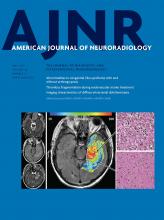Index by author
Michel, P.
- FELLOWS' JOURNAL CLUBAdult BrainOpen AccessSite and Rate of Occlusive Disease in Cervicocerebral Arteries: A CT Angiography Study of 2209 Patients with Acute Ischemic StrokeD.C. Rotzinger, P.J. Mosimann, R.A. Meuli, P. Maeder and P. MichelAmerican Journal of Neuroradiology May 2017, 38 (5) 868-874; DOI: https://doi.org/10.3174/ajnr.A5123
The authors used CTA to assess arterial stenosis and occlusion in an ischemic stroke population arriving at a tertiary stroke center within 24 hours of symptom onset to obtain a comprehensive picture of occlusive disease pattern. Extra- and intracranial pathology, defined as stenosis of ≥50% and occlusions, were registered and classified into 21 prespecified segments. In the 50,807 arterial segments available for revision, 1851 (3.6%) abnormal segments were in the ischemic (symptomatic) territory and another 408 (0.8%) were outside it (asymptomatic). In the 1211 patients with ischemic stroke imaged within 6 hours of symptom onset, 40.7% had symptomatic large, proximal occlusions. They conclude that CTA in patients with acute ischemic stroke shows large individual variations of occlusion sites and degrees. Approximately half of patients have no visible occlusive disease, and 40% imaged within 6 hours show large, proximal segment occlusions amenable to endovascular therapy.
Mitchell, J.R.
- Head and Neck ImagingYou have accessMRI-Based Texture Analysis to Differentiate Sinonasal Squamous Cell Carcinoma from Inverted PapillomaS. Ramkumar, S. Ranjbar, S. Ning, D. Lal, C.M. Zwart, C.P. Wood, S.M. Weindling, T. Wu, J.R. Mitchell, J. Li and J.M. HoxworthAmerican Journal of Neuroradiology May 2017, 38 (5) 1019-1025; DOI: https://doi.org/10.3174/ajnr.A5106
Mosimann, P.J.
- FELLOWS' JOURNAL CLUBAdult BrainOpen AccessSite and Rate of Occlusive Disease in Cervicocerebral Arteries: A CT Angiography Study of 2209 Patients with Acute Ischemic StrokeD.C. Rotzinger, P.J. Mosimann, R.A. Meuli, P. Maeder and P. MichelAmerican Journal of Neuroradiology May 2017, 38 (5) 868-874; DOI: https://doi.org/10.3174/ajnr.A5123
The authors used CTA to assess arterial stenosis and occlusion in an ischemic stroke population arriving at a tertiary stroke center within 24 hours of symptom onset to obtain a comprehensive picture of occlusive disease pattern. Extra- and intracranial pathology, defined as stenosis of ≥50% and occlusions, were registered and classified into 21 prespecified segments. In the 50,807 arterial segments available for revision, 1851 (3.6%) abnormal segments were in the ischemic (symptomatic) territory and another 408 (0.8%) were outside it (asymptomatic). In the 1211 patients with ischemic stroke imaged within 6 hours of symptom onset, 40.7% had symptomatic large, proximal occlusions. They conclude that CTA in patients with acute ischemic stroke shows large individual variations of occlusion sites and degrees. Approximately half of patients have no visible occlusive disease, and 40% imaged within 6 hours show large, proximal segment occlusions amenable to endovascular therapy.
Murad, M.H.
- Extracranial VascularYou have accessSelective-versus-Standard Poststent Dilation for Carotid Artery Disease: A Systematic Review and Meta-AnalysisO. Petr, W. Brinjikji, M.H. Murad, B. Glodny and G. LanzinoAmerican Journal of Neuroradiology May 2017, 38 (5) 999-1005; DOI: https://doi.org/10.3174/ajnr.A5103








